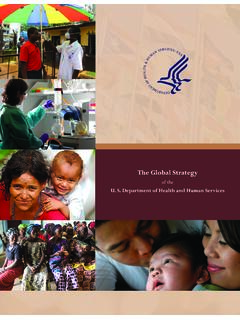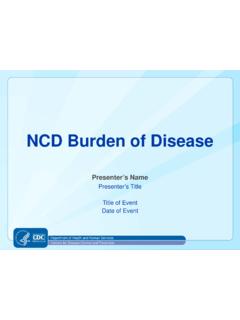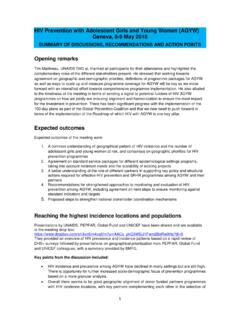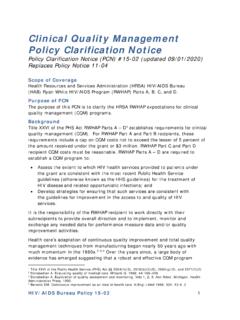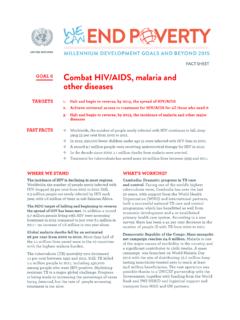Transcription of Global progress report on HIV, viral hepatitis and ...
1 Global progress report on HIV, viral hepatitis and sexually transmitted infections, 2021. Accountability for the Global health sector strategies 2016 2021: actions for impact Web Annex 1: Key data at a glance Global progress report on HIV, viral hepatitis and sexually transmitted infections, 2021. Accountability for the Global health sector strategies 2016 2021: actions for impact Web Annex 1: Key data at a glance Global progress report on HIV, viral hepatitis and sexually transmitted infections, 2021. Accountability for the Global health sector strategies 2016 2021: actions for impact. Web Annex 1. Key data at a glance ISBN 978-92-4-003098-5 (electronic version).
2 World Health Organization 2021. Some rights reserved. This work is available under the Creative Commons Attribution- NonCommercial-ShareAlike IGO licence (CC BY-NC-SA IGO; https://creativecommons. org/licenses/by-nc- ). Under the terms of this licence, you may copy, redistribute and adapt the work for non- commercial purposes, provided the work is appropriately cited, as indicated below. In any use of this work, there should be no suggestion that WHO endorses any specific organization, products or services. The use of the WHO logo is not permitted. If you adapt the work, then you must license your work under the same or equivalent Creative Commons licence.
3 If you create a translation of this work, you should add the following disclaimer along with the suggested citation: This translation was not created by the World Health Organization (WHO). WHO is not responsible for the content or accuracy of this translation. The original English edition shall be the binding and authentic edition . Any mediation relating to disputes arising under the licence shall be conducted in accordance with the mediation rules of the World Intellectual Property Organization ( amc/en/mediation/rules/). Suggested citation. Web Annex 1. Key data at a glance. In: Global progress report on HIV, viral hepatitis and sexually transmitted infections, 2021.
4 Accountability for the Global health sector strategies 2016 2021: actions for impact. Geneva: World Health Organization; 2021. Licence: CC BY-NC-SA IGO. Cataloguing-in-Publication (CIP) data. CIP data are available at Sales, rights and licensing. To purchase WHO publications, see To submit requests for commercial use and queries on rights and licensing, see http://www. Third-party materials. If you wish to reuse material from this work that is attributed to a third party, such as tables, figures or images, it is your responsibility to determine whether permission is needed for that reuse and to obtain permission from the copyright holder.
5 The risk of claims resulting from infringement of any third-party-owned component in the work rests solely with the user. General disclaimers. The designations employed and the presentation of the material in this publication do not imply the expression of any opinion whatsoever on the part of WHO. concerning the legal status of any country, territory, city or area or of its authorities, or concerning the delimitation of its frontiers or boundaries. Dotted and dashed lines on maps represent approximate border lines for which there may not yet be full agreement. The mention of specific companies or of certain manufacturers' products does not imply that they are endorsed or recommended by WHO in preference to others of a similar nature that are not mentioned.
6 Errors and omissions excepted, the names of proprietary products are distinguished by initial capital letters. All reasonable precautions have been taken by WHO to verify the information contained in this publication. However, the published material is being distributed without warranty of any kind, either expressed or implied. The responsibility for the interpretation and use of the material lies with the reader. In no event shall WHO be liable for damages arising from its use. Layout by 400 Communications. Photos by John Rae. 1. Global disease burden HIV, 2020 viral hepatitis , 2019b Sexually transmitted infections, 2020c Incidence million [ million] million [ million] 128 million [90 174 million] new cases of (number) people acquiring HIV people newly infected with Chlamydia trachomatis infection hepatitis B virus 82 million [48 130 million] new cases of million [ million] Neisseria gonorrhoea infection people newly infected with 156 million [96 236 million] new cases of hepatitis C virus Trichomonas vaginalis infection million [ million] new cases of Treponema pallidum infection (syphilis).
7 473 [385 561] congenital syphilis cases per 100 000 live births in 2016d 604 000 new cases of cervical cancer in 2020e Prevalence million [ million] 296 million [228 423 million] 128 million [107 153 million] prevalent (number) people living with HIV people living with chronic cases of Chlamydia trachomatis infection hepatitis B virus infection 29 million [19 42 million] prevalent cases 6 million [4 11 million] of Neisseria gonorrhoea infection children younger than five 105 million [83 133 million] prevalent living with hepatitis B virus cases of Trichomonas vaginalis infection infection million [ million] prevalent 58 million [46 76 million] cases of Treponema pallidum infection people living with chronic (syphilis).
8 hepatitis C virus infection Prevalence (%) [ ] adult HIV [ ] prevalence [ ] prevalence of Chlamydia prevalence among people of hepatitis B infection in trachomatis infection among people 15 49 years old the general population 15 49 years old [ ] prevalence [ ] prevalence of gonorrhoea of hepatitis B infection among people 15 49 years old among children younger [ ] prevalence of than five years Trichomonas vaginalis infection among [ ] prevalence people 15 49 years old of hepatitis C infection in [ ] prevalence of syphilis the general population among people 15 49 years old Mortality 680 000 [480 000 million] 820 000 [450 000 950 000] 204 000 deaths from congenital syphilis (number) people dying from HIV-related people dying from hepatitis in 2016d causes B-related causes 341 000 deaths from cervical cancer in 290 000 [230 000 580 000] 2020e people dying from hepatitis C-related causes Sources: a UNAIDS/WHO estimates, 2021.
9 B WHO, 2021. c WHO, 2021. d Korenromp EL, Rowley J, Alonso M, Brito de Mello M, Wijesooriya NS, Mahian SG et al. Global burden of maternal and congenital syphilis and associated adverse birth outcomes estimates for 2016 and progress since 2012. PLoS ONE. 2019; 14: e0211720. e Global Cancer Observatory: cancer today [website]. Lyon: International Agency for Research on Cancer; 2021 ( , accessed 13 May 2021). 2 Web Annex 1: Key data at a glance Regional disease burden HIV. WHO region Adult HIV prevalence (%), People living with HIV, People acquiring HIV, People dying from HIV- 2020 2020 2020 related causes, 2020. African Region 25 400 000 880 000 460 000.
10 [ ] [20 700 000 30 300 000] [590 000 1 300 000] [320 000 680 000]. Region of the 3 700 000 150 000 45 000. Americas [ ] [2 800 000 4 600 000] [110 000 210 000] [30 000 63 000]. South-East 3 700 000 100 000 82 000. Asia Region [ ] [2 800 000 4 400 000] [71 000 130 000] [55 000 130 000]. European 2 600 000 170 000 40 000. Region [ ] [2 300 000 3 000 000] [140 000 200 000] [31 000 51 000]. Eastern < 420 000 41 000 17 000. Mediterranean [< ] [370 000 550 000] [35 000 60 000] [14 000 24 000]. Region Western 1 900 000 120 000 41 000. Pacific Region [ ] [1 400 000 2 400 000] [78 000 150 000] [24 000 63 000]. Source: UNAIDS/WHO estimates, 2021. Regional disease burden 3.










